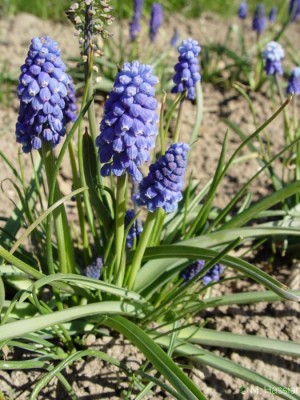
|
|
Muscari
- Muscari botryoides
|
Muscari - Grape Hyacinth (Muscari spp.)
Muscari is a genus of 50 species of
bulbs, commonly called grape hyacinths, occurring from sea level to sub-alpine areas in the Mediterranean region and South West
Asia. The fleshy leaves are arranged in basal clusters with flowers borne in dense spikes on leafless stems in
spring.
The name of the genus, Muscari, comes from the Greek word for
"moschos" meaning 'musk' and refers to the sweet aromatic scent of the flowers
which, together with their often deep blue colouring, has made them popular in
cultivation. The common name is grape hyacinth, from the way their flowerhead resembles that of a
hyacinth.
Muscari look their best grown in large massed plantings such as those which can be seen on the Rock
Garden, Battleston Hill and in the Wild Garden, where they thrive in full sun and the
moist, well-drained soil that they require.
Grape Hyacinths have been gardened for
centuries.
They are native to Greece and the Middle East, but have been grown in the UK since 1576 and were very familiar to the
Elizabethans, but were likely gardened even in the Greek & Roman ages. An
Anglo-Saxon translation of Dioscorides preserves an otherwise forgotten myth of their
origin, the first grape hyacinths having sprung from spilled dragon's blood on a forested mountain
peak.
The Grape Hyacinth, has, like the Wild
Hyacinth, a poisonous bulb. The small, dark blue flowers, looking almost like little berries and having a sweet
scent. A few of the uppermost are of a pale blue, erect, much narrower and without stamens or
pistils. As the flowers of the various species of Muscari secrete much nectar, they are reckoned among the useful bee plants of the
spring. The Grape Hyacinth has sometimes been called Starch Hyacinth, as the flowers have been supposed to smell of wet
starch.
Muscari has been used in medicine for its diuretic and stimulant
properties, but British experts do not advise or recommend that any part of Grape Hyacinth is
eaten.
However Italians have deferent
opinion. Lampagioni, a species
of Muscari, also called lampascioni or cipollacci, are often used in Southern Italian
cuisine, especially in the Puglia region. They are a kind of bulb, similar to an
onion, with a rather strong, bitter taste. After cooking they become reddish. Prior to
cooking, the outer leaves must be removed and the bulbs should soak in cool water
(which should be changed occasionally) so that some of their bitterness is lost. Otherwise they can be half
cooked, drained, and cooked in fresh water until they are done. They are used in
salads, fried, and marinated in oil or vinegar.
Source:
http://www.rhs.org.uk/
WhatsOn/gardens/wisley/archive/wisleypcimarch.asp
http://www.paghat.com/muscaribotryoides.html
http://www.botanical.com/botanical/mgmh/h/hyagra42.html
http://home.tiscali.nl/~hennessy/teeltweb/use/nieuwe_pagina_2.htm
